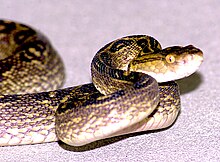Protobothrops flavoviridis
| Protobothrops flavoviridis | |
|---|---|

| |
| Scientific classification | |
| Kingdom: | |
| Phylum: | |
| Subphylum: | |
| Class: | |
| Order: | |
| Suborder: | |
| Family: | |
| Subfamily: | |
| Genus: | |
| Species: | T. flavoviridis
|
| Binomial name | |
| Trimeresurus flavoviridis (Hallowell, 1861)
| |
| Synonyms | |
| |
Trimeresurus flavoviridis is a venomous pit viper species endemic to the Ryukyu Islands of Japan. No subspecies are currently recognized.[5]
Description
Growing to an average total length of 4–5 feet (122–152 cm), with a maximum total length of 7.9 feet/242 cm (caught in 2011 at Onna, Okinawa),[6] it is the largest member of its genus. It is slenderly built and gracefully proportioned with a large head. The tail, however, is not prehensile.[3]
Scalation includes 35 (sometimes 31, 33, 37 or 39) rows of dorsal scales at midbody, 217-239 ventral scales, 72-95 subcaudal scales, and 7-10 supralabial scales.[2] The crown is covered with small scales.[3]
The color pattern consists of a light olive of brown ground color, overlaid with elongated dark green or brownish blotches. The blotches have yellow edges, sometimes contain yellow spots, and frequently fuse to produce wavy stripes. The belly is whitish with dark coloring along the edges.[3]
Common names
Habu (ハブ),[2] Okinawa habu,[3] yellow-green tree viper,[7] Hon habu (ホンハブ), Okinawan habu, Kume Shima habu (for T. f. tinkhami).[4]
Geographic range
Trimeresurus flavoviridis is found in Japan in the Ryukyu Islands, including Okinawa and the Amami Islands. The type locality given is "Amakarima Island (one of the Loo-Choo group)" (= Keramashima, Ryukyu Islands).[1]
It is common on the larger volcanic islands, but not present on the smaller coral islands [3]
Habitat
Often reported in the transition zone between palm forest and cultivated fields. Found on rock walls and in old tombs and caves.[3]
Behavior
Terrestrial[4] and mostly nocturnal, it often enters homes and other structures in search of rats and mice. Bold and irritable, it can strike quickly and has a long reach.[3]
Reproduction
Oviparous, it is one of the few pitvipers that lays eggs.[3] Mating takes place in early spring and up to 18 eggs are laid in mid-summer. The hatchlings, which emerge after an incubation period of 5–6 weeks, are 10 inches (25 cm) in length and look the same as the adults.[4]
Predators
To reduce the population of T. flavoviridis on the island of Okinawa, the small Indian mongoose, Herpestes javanicus, was introduced in 1910. Although the effects of this introduction have not been studied, in other such cases the negative effects on species of native birds, mammals, and herpetofauna have been a source of concern for wildlife managers.[8]
Venom
The incidence of snakebite in the Amami Islands is 2 per 1,000 people, which is very high. The venom of this species is of high toxicity containing cytotoxin and haemorrhagin components,[9] yet the fatality rate is less than 1%.[10] If a bite victim receives medical care promptly, bites are not life-threatening. However, 6-8% do suffer permanent disability.[3]
Brown (1973) gives LD50 values of 3.1, 4.3, 3.7, 2.7, 3.7, 3.8 mg/kg IV, 5.1 mg/kg IP and 6.0, 3.5-5.0, 4.5 mg/kg SC for toxicity.[7]
Exploitation
On the island of Okinawa, this species is heavily collected, primarily for use in habu sake (ハブ酒). (Sake in Japanese can refer to any alcoholic beverage.) In this case, the sake is a liquor called awamori (泡盛), alleged to have medicinal properties. The production includes the snakes in the fermentation process and it is sold in bottles that may or may not contain the body of a snake.[11]
See also
![]() Media related to Protobothrops flavoviridis at Wikimedia Commons
Media related to Protobothrops flavoviridis at Wikimedia Commons
- List of crotaline species and subspecies
- Trimeresurus by common name
- Trimeresurus by taxonomic synonyms
- Crotalinae by common name
- Crotalinae by taxonomic synonyms
- Snakebite
- Habushu
References
- ^ a b McDiarmid RW, Campbell JA, Touré T. 1999. Snake Species of the World: A Taxonomic and Geographic Reference, Volume 1. Herpetologists' League. 511 pp. ISBN 1-893777-00-6 (series). ISBN 1-893777-01-4 (volume).
- ^ a b c Gumprecht A, Tillack F, Orlov NL, Captain A, Ryabov S. 2004. Asian Pitvipers. GeitjeBooks. Berlin. 1st Edition. 368 pp. ISBN 3-937975-00-4.
- ^ a b c d e f g h i j U.S. Navy. 1991. Poisonous Snakes of the World. US Govt. New York: Dover Publications Inc. 203 pp. ISBN 0-486-26629-X.
- ^ a b c d Mehrtens JM. 1987. Living Snakes of the World in Color. New York: Sterling Publishers. 480 pp. ISBN 0-8069-6460-X.
- ^ "Trimeresurus flavoviridis". Integrated Taxonomic Information System. Retrieved 25 July 2008.
- ^ http://www.eikanken-okinawa.jp/news/news23/image/23page1.pdf 全長 242cmのハブを捕殺 最長記録を更新! 沖縄県衛生環境研ニュース
- ^ a b Brown JH. 1973. Toxicology and Pharmacology of Venoms from Poisonous Snakes. Springfield, Illinois: Charles C. Thomas. 184 pp. LCCCN 73-229. ISBN 0-398-02808-7.
- ^ Hays WST, Conant S. 2007. Biology and Impacts of Pacific Island Invasive Species. 1. A Worldwide Review of Effects of the Small Indian Mongoose, Herpestes javanicus (Carnivora: Herpestidae). Pacific Science 61 (1): 3-16.
- ^ Venomous Snakes of the World by Mark O'Shea, Page number 106
- ^ http://www.eikanken-okinawa.jp/seitaiG/habu/houkokusyo/H23houkoku.pdf 沖縄県における平成23 年の毒蛇咬症 沖縄県衛生環境研究所. According to this report, 8901 snakebites from this snake are reported during 1964-2011 in Okinawa prefecture(Amami excluded). Among those, fatalities are 53. So, fatality rate is around 0.6%.
- ^ Okinawa’s potent habu sake packs healthy punch, poisonous snake at Stars and Stripes. Accessed 7 December 2008.
Further reading
- Hallowell, E. 1861. Report upon the Reptilia of the North Pacific Exploring Expedition, under command of Capt. John Rogers, U. S. N. Proc. Acad. Nat. Sci. Philadelphia 12: 480-510. (Bothrops flavoviridis, pp. 492–493.)
External links
- Protobothrops flavoviridis at the Reptarium.cz Reptile Database. Accessed 25 July 2007.
